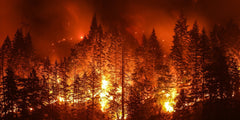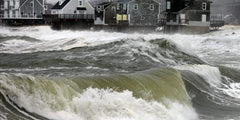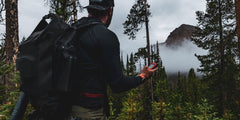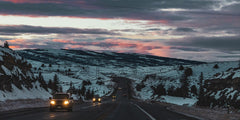
Important Fire Safety Facts for Forest Fire Prevention and Survival
Forest fires pose an immense threat to our ecosystem and our homes. The entire western United States is at high risk of wildfire. Even Florida, Minnesota, and Wisconsin have had some huge fires. It’s no wonder the United States has an overall fire management budget of $2.25 billion. Despite increasing our national budget by 60% from 10 years ago, it likely won’t be enough.

In 2018, and only half way through the fiscal year, the State of CA spent nearly $500 million. That does not include the costs of individual cities and departments, only the state. In 2017, there were $11.5 billion in insurance claims in CA (source: http://fortune.com/2018/09/06/california-fire-2018-cost-insurance-claims/).
Rising temperatures and increasing droughts are causing some of our largest forests to become dry and vulnerable to sweeping forest fires.
We are all under obligation to do our best to prevent forest fires from decimating our homes and communities any way we can. In addition to learning how to prevent forests fires, it’s incredibly valuable to have the knowledge to survive a wildfire if you find yourself in dire circumstances.
Have a specific question in mind? Jump to the related section using the links below:
- Wildfire Causes
- Fire Hazards
- Controlled Burns
- Campfire Safety
- Firework Safety Rules
- Preventing Wildfires
- Fire Escape Plan
Wildfire Causes
There are two types of causes when it comes forest fires, human and natural. Natural forest fires are typically the result of lightning with a much smaller percentage being caused by spontaneous combustion. The latter of the two is usually caused by an incredibly dry climate.
When dead leaves, branches, and foliage gather and become extremely dry, heat and sunlight may cause these clusters to ignite.
The most common wildfire cause is human action.

There may be a number of reasons forests ignite as a result of humans. Here are just a few:
- Cigarettes
- Campfires
- Timber equipment (machinery, tools, & internal combustion engines in general, i.e. motorcycles, welding)
- Fireworks
- Controlled burns
- Arson (an increasing cause of wildfires)
- Down or arcing power lines
- General carelessness
While wildfires caused by human error are more common, they tend to destroy a smaller area because they’re easier to detect and stop once they start. This is because human-caused fires happen closer to populated areas and get reported faster than forest fires caused by lightning or combustion. While the odds of a man made fire being reported early are higher, this is not always the case. There have been several recent incidents of camp fires, power lines, and vehicles being responsible for starting fires in remote areas.
When lightning strikes or combustion occurs deep in the middle of a forest, it can take hours before someone detects it, and even longer to dispatch the equipment and manpower to stop the fire.
Fire Hazards
There are three necessary elements needed to create and maintain a forest fire. Those three elements are fuel, oxygen, and heat.

Fire hazards are anything that contributes to or creates one of these three elements. The following are all common examples of common forest fire hazards:
- Heat waves
- Droughts
- High-pressure ridges
- Strong winds
- Thunderstorms
- Low humidity
- High fuel loads
Unfortunately, natural fire hazards such these are out of our hands. While humans do contribute to rising temperatures and drought, these happening are inevitable. Climate change is cyclical, with highs and lows, however, we can make a positive impact by reducing our carbon footprint.
Controlled Burns
States that have particularly high rates of wildfires will reduce their risk of widespread damage by burning off sections of land so large fires will get cut off before they go any further.
Sometimes referred to as swailing or burn-off, controlled burns may be used for a variety of purposes outside of forest fire prevention.
Controlled burns usually happen during the cooler months of the year, so that when summer rolls around there will be less build-up of combustible debris.
Some seeds and trees have adapted and evolved to survive, and even thrive as a result of fires. Example: Lodge pines and sequoias will drop cones that disperse seeds when exposed to heat.
Campfire Safety
Campfire safety is critical when preventing forest fires; so critical that it made Smokey Bear’s five rules of wildfire prevention.
While campfires are a lot of fun, they also come with serious responsibility. There are four things you need to keep in mind while setting up a campfire:
- Location: Make sure your campfire location is at least 15 feet away from tents, walls, or combustible vegetation. Never build a campfire in a hazardous, dry condition.
- Preparation: clear the area you plan to dig your pit in a 10 ft diameter. Make sure your pit is at least one foot deep and you surround the edges with rocks to catch sparks.
- Building your fire: Gather ethical and ecological sources of fuel like wood and shrubbery to fill your fire pit with and light it with matches or a lighter.
- How to maintain and extinguish your fire: Use larger pieces of wood to keep your fire going and never let it get to an unmanageable size. Pour water and cover your fire with dirt so its coals are completely extinguished.
Be sure to follow these guidelines and make Smokey proud.
Fireworks Safety Rules
Fireworks are one of the largest human-related causes of wildfires. It’s of utmost importance that you take extra precautions when handling and using fireworks—especially in dry climates.

In addition to causing fires, fireworks also send many people to the hospital each year with burns and other injuries.
Always look up city ordinance laws regarding firework safety. While the umbrella laws for fireworks will remain the same across the state, city laws will likely vary.
Never light your fireworks off when there are potential forest fire hazards nearby and always keep a fire extinguisher handy during the entire process. If you don’t have access to a fire extinguisher, keep a few buckets of water handy at the very least.
Safety glasses and gloves to protect your eyes and hands should always be worn as well.
Preventing Wildfires
Learning how to prevent wildfires is a lot easier than you might think, and can have a significant impact.
Here are some the most important fire prevention tips:
- Build and monitor responsible fires: Some states allow for the burning of shrubbery and other natural materials; never burn any unapproved fuel. When building a campfire, it’s extremely important that you constantly monitor your fire and take all precautionary measures. When you finish using your campfire, make sure it’s completely extinguished before leaving.
- Never burn in windy conditions.
- Report anything suspicious to the authorities: If you suspect that wildfire has started close-by, don’t hesitate to call 911.
- Dispose of flammable/hazardous waste responsibly: lit cigarettes and even lighters can be toxic for the environment or pose a potential wildfire threat. When it comes to understanding how to prevent forest fires, it’s extremely important to practice safe disposal practices. Never discard a cigarette out of a moving car; the dry shrubbery on the side of the road may easily ignite.
- Follow state laws and city ordinances regarding backyard burn disposal. Remove any potentially hazardous material from the surrounding area of your burn before you get started and set up a non-flammable parameter the same way you would with a campfire.
With these helpful skills and pieces of fire safety knowledge, you can help prevent forest fires.
Create a Defensible Space
If you live in an area of high fire danger, you can help to protect your home by creating an area of defensible space around your home and other buildings. By doing so you give your home a better chance of surviving a fire and make it easier for firefighters to save your home. Here are a few guidelines for creating defensible space:
- Home Ignition Zone - Within 30’ of your home, remove all combustible material including furniture, door mats, yard tools, garbage cans, combustible mulch or vegetation, smaller trees, bushes, dry grass, leaves, pine needles, wood chips, overhanging branches, combustible fences and decks.
- Defensible Space – From 30 – 100’ of your home, remove dead grass, shrubs or trees. Limb larger trees 10 -15’ from ground. Reduce density of vegetation to 10’ between widest part of trees/bushes. Remove highly flammable plants that contain resins, oils and waxes: ornamental juniper, paupon, holly, red cedar, manzanita, young pine.
- Wildland Reduction Zone – from 100 – 150’, clear undergrowth, small trees and flammable brush. Chip or remove combustible debris.
- Flammable trees and bushes should have at least 10’ between foliage. Trim dead limbs at least 12 feet from ground level.
Fire Escape Plan
If you live in a high-risk area, it’s critical that you create a fire safety plan and stock up on supplies and survival equipment for emergencies. If you live in a remote area, it’s especially important to be prepared with a bug-out-bag to keep you alive in dire circumstances.
If your community has an automatic emergency alert system, be sure to register and sign up for it. Contact your local emergency services for information.
Every emergency plan should include a battery powered AM/FM/NOAA radio to receive alerts and information. But remember, you may not always receive a notification from local emergency services if cell towers become overloaded.
If you have children, map out a routine that you can practice at least twice a year. Determine safe meeting locations and come up with safe words.
Common fire-related disaster preparedness tips suggest that you learn how to safely run through smoke in burning wooded or grassy areas in case you get caught in the middle of a disaster.

- Run as low as possible towards the wind
- Use a damp or wet cloth to cover your mouth while you run to filter out the smoke as you inhale
- If possible, run towards a body of water if you’re concerned with becoming trapped
- Look for areas of little fuel such as rock outcroppings, large cul-de-sacs, parks, golf courses, or even the blacked-out area the fire has already burned. Survey your neighborhood so that you know at least two escape routes and any areas of safe refuge.
- Stay out of canyons and saddles as this is where the winds will carry the fire.
- If possible, wrap yourself in a wool blanket and wear cotton or wool clothes. Most man made fibers will melt to your skin.
Forest fires can turn into chaotic situations in a matter of seconds. Families getting split-up in the midst of confusion isn’t uncommon. Be sure to create a safe meetup location for everyone in your household in the event of a separation.
Consider printing a list of disaster preparedness tips to keep with your bags of emergency supplies. Even if you practice your escape routines regularly, it can be easy to forget amidst the discord.
While a plan is vital to survival, tools and supplies are arguably even more so. Depending on how remote your location is, it may be days before rescuers make it to your location.
Include water, food, medical supplies, and any other lightweight survival gear that you can carry. If survival shopping isn’t your forte, Uncharted sells bags with everything you need to survive any emergency scenario.
Without the proper supplies, you could end up suffering from dehydration, starvation, and even infection if you aren’t careful. If you want to ensure you and your family’s safety, it’s more than worthwhile to invest in a survival gear and supplies for emergency situations.
Practice
Practice is essential. Having a plan with tools and supplies are good. But unless you practice your plan and use your tools regularly, they may be useless when you need them. Children love organized practice (school fire drills) and will be less stressed and more resilient if you ever need to implement your emergency plan. Just gear your expectations and explanations to their age level. Practice prevents panic. Everyone will do much better when a crisis strikes.
Evacuation
In a crisis, time is of the essence. If evacuation is needed, be the first to leave not the last (hurricane, fire, flood, riot, etc.). Roads will become clogged with traffic and many people will need to abandon their vehicles as we saw in recent California wildfires. It is better to leave prematurely and come back when safe to do so than to die in your car, house or roadside.




